
The Solar-Terrestrial Centre of Excellence (STCE) is a collaborative network of the Belgian Institute for Space Aeronomy, the Royal Observatory of Belgium and the Royal Meteorological Institute of Belgium.
 |
Published by the STCE - this issue : 19 Dec 2014. The Solar-Terrestrial Centre of Excellence (STCE) is a collaborative network of the Belgian Institute for Space Aeronomy, the Royal Observatory of Belgium and the Royal Meteorological Institute of Belgium. |
| Archive of the newsletters | Subscribe to this newsletter by mail |
Solar flare activity fluctuated between low and moderate during the week.
In order to view the activity of this week in more detail, we suggest to go to the following website from
which all the daily (normal and difference) movies can be accessed: http://proba2.oma.be/ssa
This page also lists the recorded flaring events.
A weekly overview movie can be found here (SWAP week 246).
http://proba2.oma.be/swap/data/mpg/movies/weekly_movies/weekly_movie_2014_12_08.mp4
Details about some of this week's events, can be found further below.
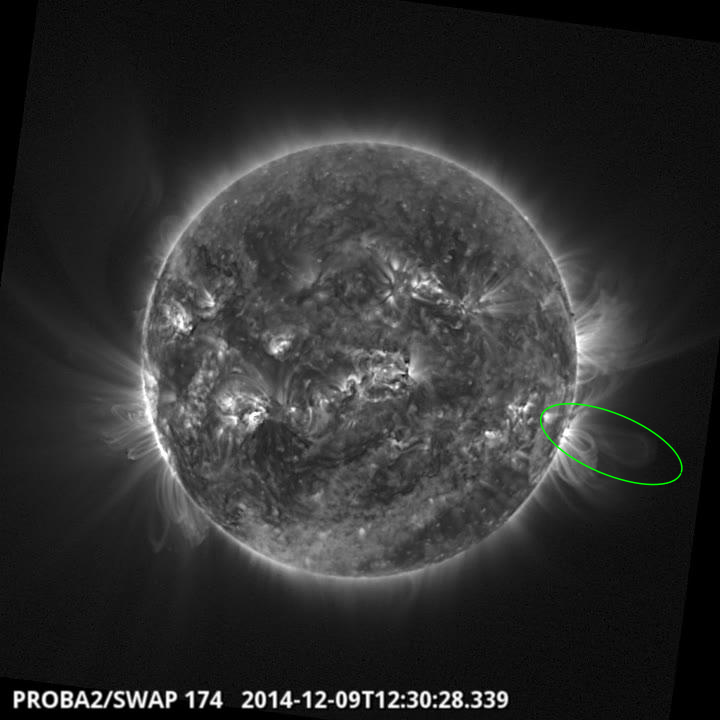
Eruption on west limb @ 12:30 SWAP image
Find a movie of the event here (SWAP movie)
http://proba2.oma.be/swap/data/mpg/movies/20141209_swap_movie.mp4

Eruption on the west limb @ 16:50 SWAP image
Find a movie of the event here (SWAP movie)
http://proba2.oma.be/swap/data/mpg/movies/20141210_swap_movie.mp4
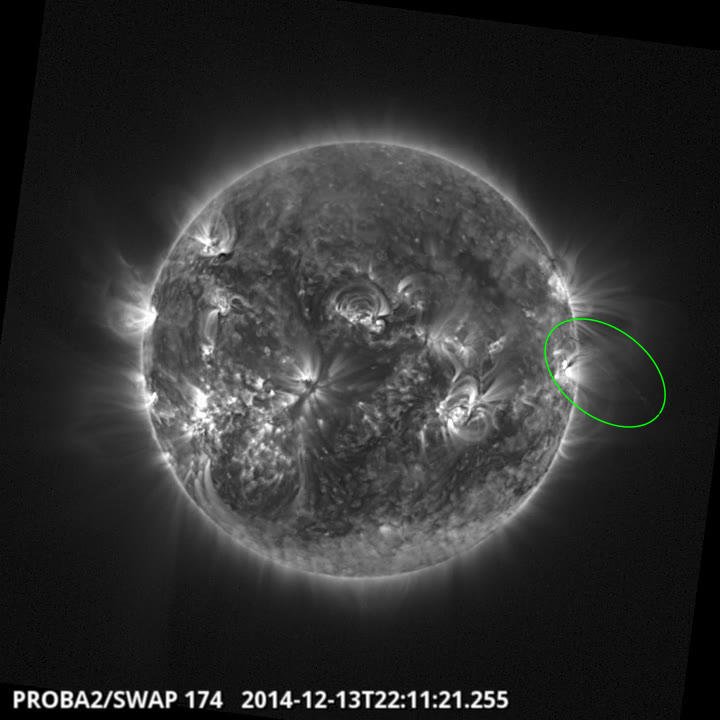
Eruption on the west limb @ 22:11 SWAP image
Find a movie of the event here (SWAP movie)
http://proba2.oma.be/swap/data/mpg/movies/20141213_swap_movie.mp4
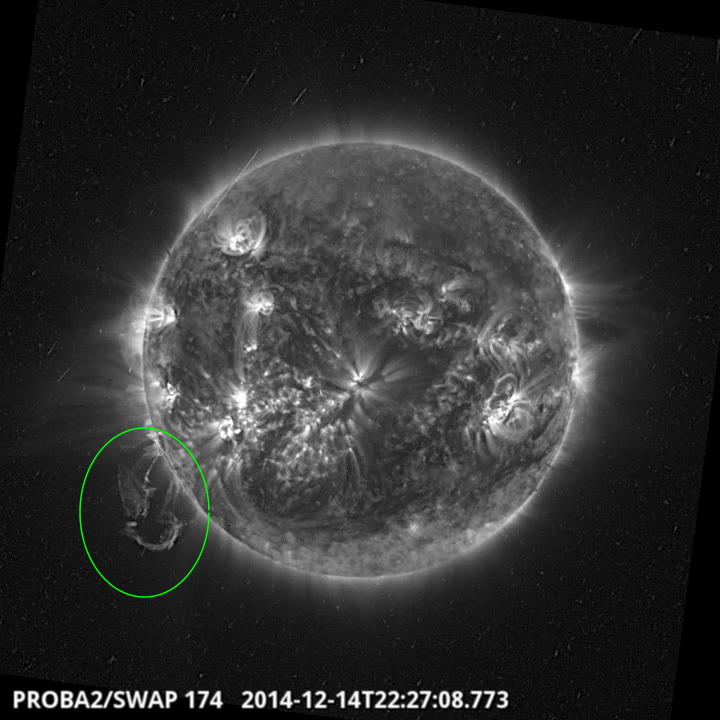
Eruption on the west limb @ 22:27 SWAP image
Find a movie of the event here (SWAP movie)
http://proba2.oma.be/swap/data/mpg/movies/20141214_swap_movie.mp4
Many C-class (55 counted in total) and two M-class flares were observed from December 8 to 14. In the beginning of the week, NOAA 2230 was the main player with 17 C-flares, of which the C8.6 and C8.5 flares on December 9 were most noteworthy. The last two days, NOAA 2241 and 2242 produced the each the most and strongest flares.
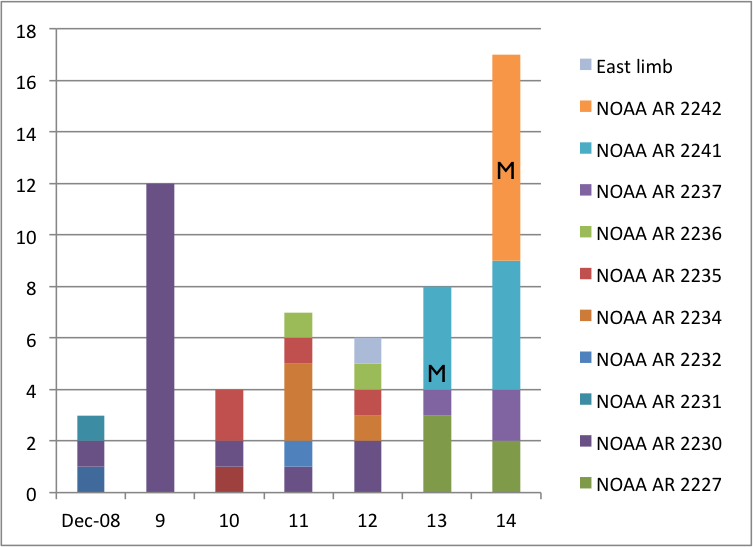
The M-class flare (M1.5 on December 13, M1.6 on December 14) originated from NOAA 2241 and 2242 respectively. The M1.6 flare was accompanied by a radio type II burst at 19:29 UT, with a shock speed of 1028 km/s (estimation of Palehua station).
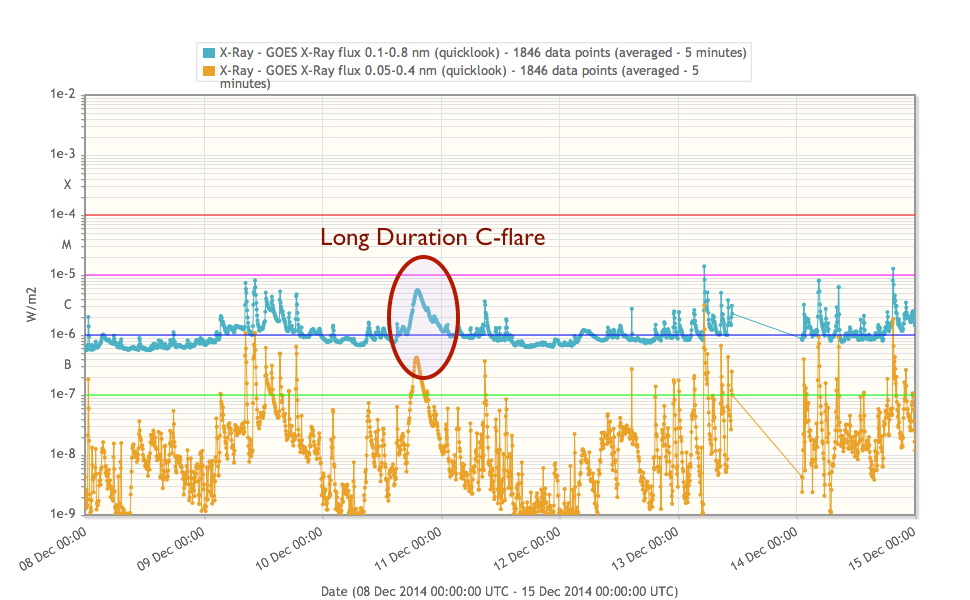
A long duration event occurred on December 10, but without any effect on Earth.
A large filament erupted on December 12, accompanied by a CME heading mostly to the North (first measurement at 4:14 UT in LASCO-C2 imagery), without any significant component in the ecliptic plane.
A proton enhancement occurred, starting somewhere at the end of December 13, but without crossing the event threshold near Earth. The timing can not be determined exactly due to a data gap in the proton flux data from ACE and GOES.
The protons are seen as the several white dots in the blue image SOHO/LASCO C3 below.
Probably the same activity caused a proton event measured at STEREO A. A possible explanation causing this proton event, is the backside activity starting at 14:20 UTC on December 13 from a region near E150S20 (old NOAA region 2222).
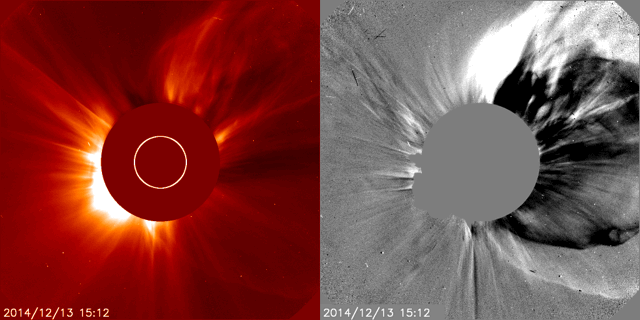
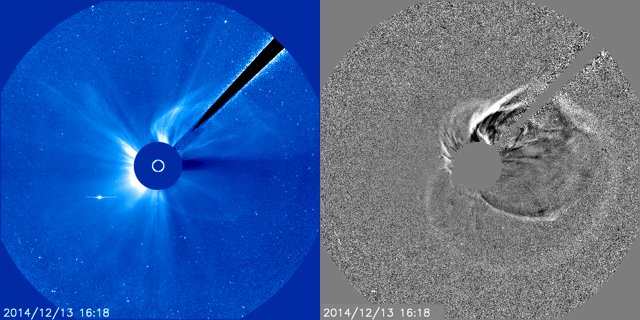
Strong flaring occurred at that moment, accompanied by a halo CME seen by SOHO/LASCO C2 and C3 (see image above), travelling away from Earth and a type II radio burst. NOAA 2227 was approaching the West limb (right as seen from Earth) and flaring activity from this region might also have contributed to the enhancement of the proton flux, though flaring mostly occurred after the start of the proton enhancement.
| DAY | BEGIN | MAX | END | LOC | XRAY | OP | 10CM | TYPE | Cat | NOAA |
| 13 | 0513 | 0520 | 0525 | M1.5 | 2241 | |||||
| 14 | 1925 | 1933 | 1939 | S19E44 | M1.6 | SF | VI/2II/2 | 2242 |
| LOC: approximate heliographic location | TYPE: radio burst type |
| XRAY: X-ray flare class | Cat: Catania sunspot group number |
| OP: optical flare class | NOAA: NOAA active region number |
| 10CM: peak 10 cm radio flux |
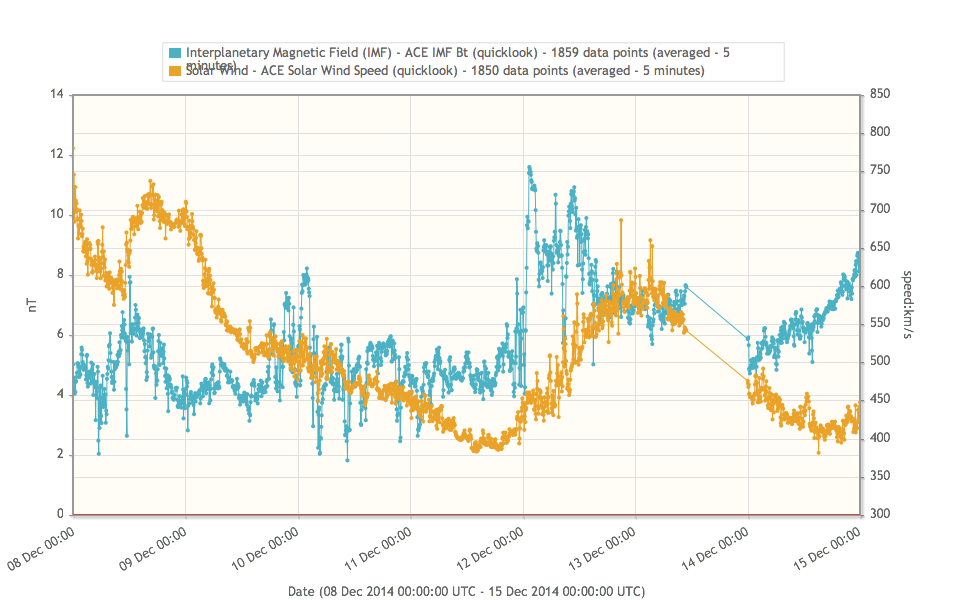
The first day the Earth was under the influence of a fast solar wind. The solar wind speed then declined from about 800 to 400 km/s on December 11. The magnitude of the Interplanetary Magnetic Field (IMF) was stable around 5nT.
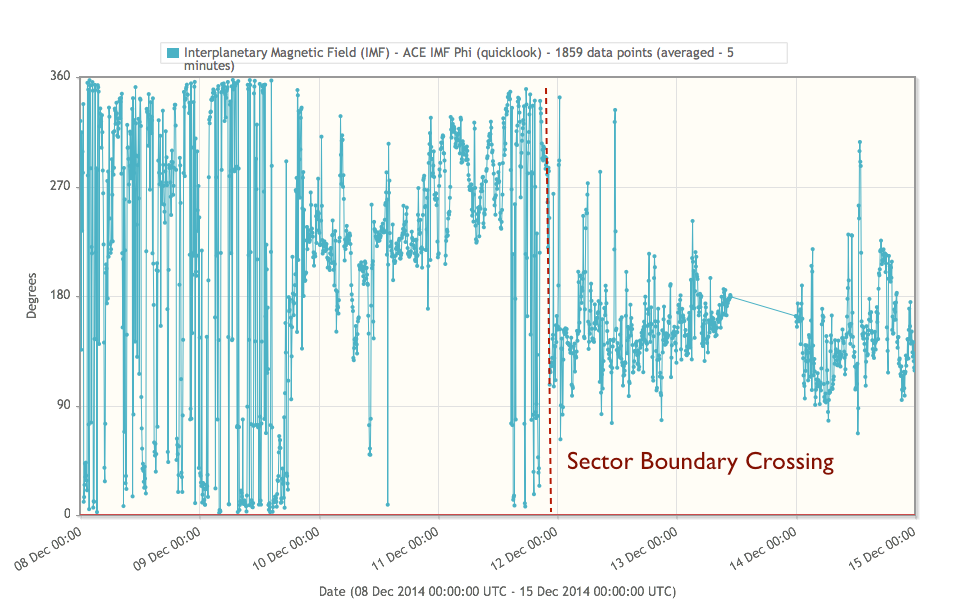
At a sector boundary crossing near 23 UT on December 11: inward pointing (Bx,By) with phi roughly between 270 and 360 degrees to outward pointing (Bx,By) with phi roughly between 90 and 180 degree. The IMF magnitude went to about 10 nT, while the solar wind speed increased again to maximally 700 km/s. The change in solar wind conditions were also due to the influence of a coronal hole high speed stream.
Geomagnetic conditions were quiet to active; the local K at Dourbes ranged from 1 to 4 and NOAA estimated KP even reached K=5 at one time slot around noon on December 12. Several time slots of active conditions occurred due to the mainly negative Bz component.
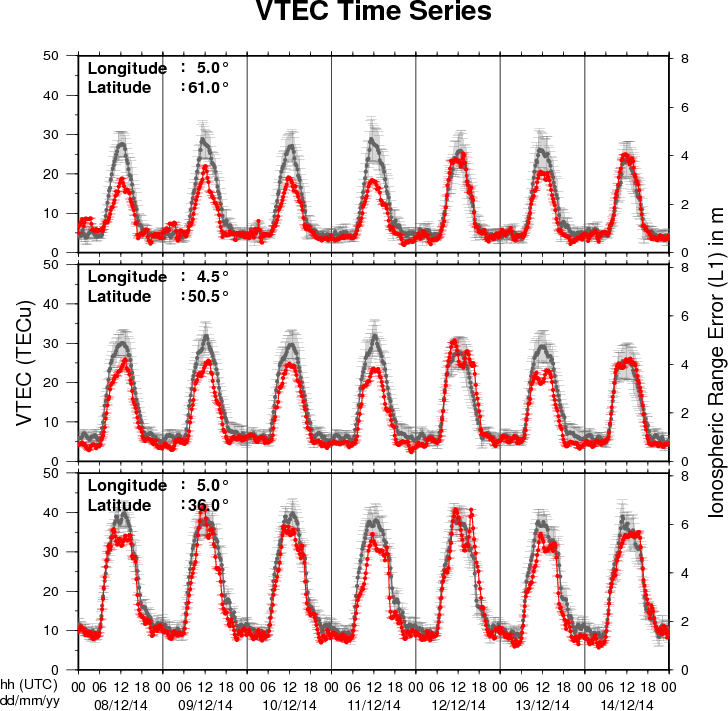
The figure shows the time evolution of the Vertical Total Electron Content (VTEC) (in red) during the last week at three locations:
a) in the northern part of Europe(N61°, 5°E)
b) above Brussels(N50.5°, 4.5°E)
c) in the southern part of Europe(N36°, 5°E)
This figure also shows (in grey) the normal ionospheric behaviour expected based on the median VTEC from the 15 previous days.
The VTEC is expressed in TECu (with TECu=10^16 electrons per square meter) and is directly related to the signal propagation delay due to the ionosphere (in figure: delay on GPS L1 frequency).
The Sun's radiation ionizes the Earth's upper atmosphere, the ionosphere, located from about 60km to 1000km above the Earth's surface.The ionization process in the ionosphere produces ions and free electrons. These electrons perturb the propagation of the GNSS (Global Navigation Satellite System) signals by inducing a so-called ionospheric delay.
See http://stce.be/newsletter/GNSS_final.pdf for some more explanations ; for detailed information, see http://gnss.be/ionosphere_tutorial.php
Start : 2015-03-16 - End : 2015-03-19
This international conference will provide an overview of our
current understanding of Sun-Climate Connections starting at
processes on the Sun itself over space weather and solar wind
towards solar influence on the upper atmosphere down to the ocean.
It will also provide insights into the heatedly debated role of the
Sun in climate change. In four sessions the various contributions
of solar variability influence on Earth's climate will be presented
and discussed by bringing together solar physicists, space
scientists, atmospheric scientists, climate modellers, and
paleoclimatologists.
We expect contributions from scientists participating in
SCOSTEP/ROSMIC, SPARC-SOLARIS/HEPPA, the EU cost network TOSCA, as
well as any other interested scientists. The conference will last
three full days, beginning Monday morning, 16 March 2013. The
programme will consist of invited and keynote lectures, a few
contributed oral presentations and ample time dedicated to poster
sessions. The fourth day will be devoted to public outreach
activities as well as panel discussions.
Website: http://scc.geomar.de/
Start : 2015-05-18 - End : 2015-05-22
URSI AT-RASC 2015 will be the first edition of the newly
established triennial URSI Atlantic Radio Science Conference as one
of the URSI Flagship Conferences. AT-RASC 2015 will have an open
scientific program composed of submitted papers within the domains
covered by all ten Commissions of URSI.
Website: http://www.at-rasc.com/
Start : 2015-06-01 - End : 2015-07-24
The Space Weather Summer School at Los Alamos National
Laboratory, established in 2011 under the founding Director Josef
Koller, is dedicated to space weather, space science and
applications. Every year we solicit applications for the Los Alamos
Space Weather Summer School. This summer school is sponsored and
supported by a number or organizations at LANL. This year our top
sponsors include the Los Alamos Institute of Geophysics, Planetary
Physics and Signatures (IGPPS) and the Laboratory Directed Research
and Development Office (LDRD). The summer school brings together
top space science students with internationally recognized
researchers at LANL in an educational and collaborative
atmosphere.
Website:
http://www.swx-school.lanl.gov/
Start : 2015-07-21 - End : 2015-07-23
The conference will review past and recent achievements, as well
as future challenges in the field of solar coronal loop
physics.
Website:
http://www.damtp.cam.ac.uk/user/astro/cl7/index.html
Start : 2015-07-28 - End : 2015-08-04
Heliophysics is all of the science common to the field of the
Sun-Earth connections. This fast-developing field of research
covers many traditional sub-disciplines of space physics,
astrophysics, and climate studies. The NASA Living with a Star
program, with its focus on the basic science underlying all aspects
of space weather, acts as a catalyst to bring the many research
disciplines together to deepen our understanding of the system of
systems formed by the Sun-Earth connection.
Website:
http://www.heliophysics.ucar.edu/
Start : 2015-07-30 - End : 2015-08-06
The 34th International Cosmic Ray Conference (ICRC) will be held
from July 30 to August 6, 2015, in The Hague, The Netherlands. It
is an important and large conference in the field of Astroparticle
Physics. The ICRC covers: cosmic-ray physics, solar and
heliospheric physics, gamma-ray astronomy, neutrino astronomy, and
dark matter physics.
Website: http://icrc2015.nl
Start : 2015-10-05 - End : 2015-10-09
This CSPM-2015 scientific meeting will cover various aspects of
solar dynamic and magnetic phenomena which are observed over the
entire electromagnetic spectrum: white-light, Hα, Ca II,
and radio from ground and in a variety of other wavelengths (white
light, UV and EUV, and X-rays) from space. Emphasis will also be
placed on instrumentation, observing techniques, and solar image
processing techniques, as well as theory and modelling through
detailed radiative transfer in increasingly realistic MHD models.
The long-term (cyclic) evolution of solar magnetism and its
consequence for the solar atmosphere, eruptive phenomena, solar
irradiation variations, and space weather, will be in focus. Here,
special attention will be devoted to the long-term observations
made in Coimbra and also to the results of the SPRING / SOLARNET
and SCOSTEP VarSITI studies. In particular, the weak solar activity
during the current solar maximum will be discussed. Finally, since
this meeting is organised around the 90th anniversary of performing
the first spectroheliographic observations in Coimbra, a session
will be specially dedicated to new solar instruments (both
ground-based and space-borne) that will give access to unexplored
solar atmospheric features and dynamic phenomena over the coming
years.
Website:
http://www.mat.uc.pt/~cspm2015/
Start : 2016-07-30 - End : 2016-08-07
The 41st COSPAR Scientific Assembly will be held in Istanbul,
Turkey from 30 July - 7 August 2016. This Assembly is open to all
bona fide scientists.
Website:
https://www.cospar-assembly.org/
Presentation, in French, given at the open doors of the Space Pole, Belgium, 2014
http://www.spaceweather.eu/en/repository/show?id=552
Lecture focusing on the effects of space weather, extreme space weather during SC24, and the space weather forecasting at the Space Pole (RWC Brussels). The lecture was given to the Public Observatory Beisbroek / COZMIX in Beisbroek, Brugge, Belgium. Solar amateur astronomers and public audience, in Dutch, about 35 attendees.
http://www.spaceweather.eu/en/repository/show?id=554
This presentation was given during the "ESWW11 – Forecaster Forum" splinter on 18 November 2014. It focuses on the forecast and evaluation of the flaring activity in sunspot group NOAA 2158 (September 2014). There were about 70 attendees (scientists).
http://www.spaceweather.eu/en/repository/show?id=555